On the day of the sarin gas attack on the Tokyo subway system in March 1995, we were shocked beyond words. It was the first act of indiscriminate terrorism in Japan. It was also the first time for most of us to hear the term “sarin.” But this nerve gas with an unfamiliar name was actually released inside subway cars, killing and injuring many people.
Victims of the sarin attack taken from the Tokyo subways on March 20, 2005
The many “firsts” combined together made us shudder with horror. It was all the more frustrating because we could not find words to aptly describe the nature of the incident. Moreover, the absence of an apparent motive added to our fear.
Looking back, I think these were the elements that made up the “shock” many of us shared.
In hindsight, our horror was foreshadowed by the Great Hanshin Earthquake that hit in January of the same year. The overwhelming power of nature suddenly struck and shattered the confidence of human society. The earthquake instantly crushed the livelihoods of many people. Just as people were beginning to accept the uncertainties of life and develop a sense of resignation, the subway sarin gas incident occurred.
Ten years later, do we know any more than we did back then? Unfortunately, the answer is “no.” The series of Aum Shinrikyo-related trials unveiled very few new facts. I don’t think this is because former Aum executives are hiding what they know or feigning innocence. Rather, they, too, seem to lack the vocabulary to explain what made them carry out the heinous crime.
Meanwhile, society has stopped asking “why religions whose mission is to deliver salvation kill people,” a fundamental question that kept nagging us immediately after the incident. Together with many other “whys,” we put it behind us.
The perpetrators may have been caught and put on trial. But unless we know the true motives behind their act, fear will continue to slowly but surely erode society like a body blow. Without overcoming fear and horror, society let hatred against Aum Shinrikyo take over and developed a propensity for crisis management.
It was thus that within a few years of the sarin attack Japan established the “Japan-U.S. guidelines for defense cooperation” and other laws that regulate citizens’ activities, with the backing of public opinion. They include the wiretapping law that allows law enforcement authorities to monitor private communications while investigating crimes, the national flag and anthem law, and the group control law, which is actually directed at Aum Shinrikyo.
All these controversial laws would have surely prompted a chorus of angry public protests had they been proposed before the sarin incident. Actually, however, they were passed with little resistance. The subway gassing incident completely loosened Japanese society’s reins over public authority.
Then the Sept. 11, 2001, terrorist attacks on the United States shook the world again.
The horror that society experienced has not disappeared or weakened in the last 10 years. On the contrary, it has become profound. At the same time, crisis management has grown and continues to change society. As a result, people have come to accept the situation as natural. I cannot help but think so.
To shoot an independently produced documentary film, I entered Aum-related facilities and looked at the outside from one of its windows. In other words, I saw society through my camera from Aum’s vantage point and realized its abnormality. What I saw was a society that refuses to use its imagination to understand others and hates and shuns those who are beyond its understanding.
People who exercise excessive self-defense can hurt themselves. A community works properly only when it is made up of people of diverse ideas. If we sit back and do nothing, we cannot cut the chain of hatred. That is why we need to recover our imagination to understand what made the perpetrators do what they did.
This is what I bear in mind as I continue to interview former Aum executives in prison.






